Video marketing has gained a lot of popularity in recent years, and rightfully so. With attention spans ranging between 8 and 12 seconds, it’s no surprise that video has become a preferred method for consuming information.
But just how effective is video marketing? Also, what kind of videos tend to do better?
For marketers to leverage video marketing in their strategies, they need to understand the ins and outs of this channel. Below, we discuss some video marketing stats that will provide valuable insights for marketers in the year 2025.

What Is Video Marketing?
Before getting into the statistics, let’s quickly go over the basics of video marketing. Video marketing is a form of content marketing in which you use any kind of video, be it long-form or short-form, to promote your offerings on a platform, from your website to a social media site.
Over the years, video has become a prominent form of marketing due to the extent of information it provides in a short amount of time. Videos are often used to showcase products, services, or even a company’s brand values.
Some types of videos brands create for marketing purposes include
- Product demos
- Explainer videos
- Testimonials
- How-to videos
- Event recaps
Besides, social media videos are also widely used to engage with audiences. From TikTok videos to Instagram Reels and Facebook long-form videos, there’s a wide range of options for marketers to choose from.
General Video Marketing Stats
The general trend around video marketing is that it has risen in use and effectiveness over the years. Also, new forms of videos have emerged in the past few years, giving brands more opportunities to reach out to their target audiences. More importantly, the use cases for video marketing have also diversified.
Here are some statistics that prove this point.
1. There are over 3.5 billion digital video viewers worldwide.
2. In a Wistia survey, 93% of businesses said that video is an important part of their marketing strategy.
3. According to Keywords Everywhere data, the organic search for ”video marketing” has been on an uptrend for the past 12 months, reaching peaks of over 7,000 monthly searches.
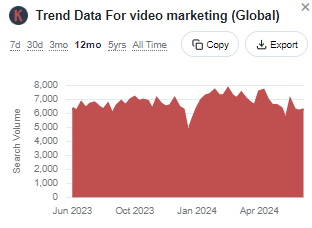
4. 38% of the marketers say that their primary goal with video marketing is to generate leads and drive sales, 31% say it’s product education and adoption, 17% cite it to be brand awareness and PR, while 8% say they create videos for social media engagement or followers.
5. By 2025, ad spending in video advertising is forecasted to reach $191.3 billion. Increasing at an annual growth rate (CAGR) of 6.04%, the value is expected to reach $241.9 billion by 2028.
6. In 2028, $193.4 billion of all ad spending in video marketing will be through mobile, which is a testament to the growing popularity of mobile marketing.
7. 91% of businesses use video marketing in their marketing strategies, which is the highest recorded percentage to date.
8. 57% of businesses plan to increase their resources for video, while 38% will allocate the same amount as they did earlier. Only 4% are expected to use less resources for video marketing.
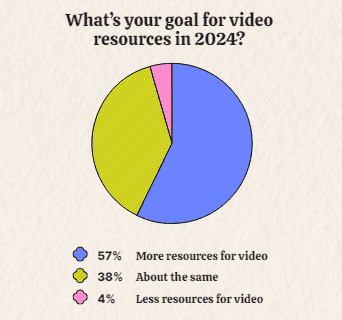
Source
9. 78% of businesses report that their goal for 2024 is to create more videos, while 1% say that they will make fewer videos.
10. In 2024, the average video ad spend per internet user is projected to be $34.5.
11. Short-form videos are expected to be a popular format for video ads, with an annual growth rate of 10.04% between 2024 and 2028. Their projected market volume in 2028 is $145.8 billion.
12. According to 88% of marketers, video is an important part of the overall marketing strategy.
13. 68% of the marketers who did not previously use video marketing plan to start in 2024.
14. Of the marketers who do not use video marketing, 33% say that lack of time is the reason behind it, followed by a lack of understanding as to where to start, with 15% of marketers citing this reason.
15. Nearly 20% of marketers do not use video marketing because they deem it too expensive.
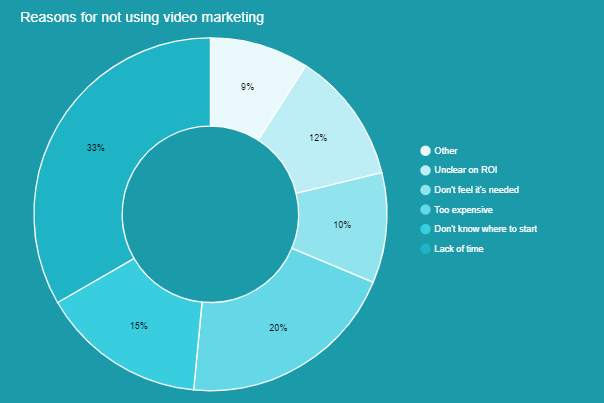
Source
Video Consumption Stats
Nowadays, users are not merely consuming videos through Connected TV or linear channels on television. Instead, users are now watching videos through a variety of devices and platforms, including laptops, smartphones, and social media.
Here are some statistics on video consumption that reveal the impact it has on businesses and consumers alike.
16. American adults spend 3 hours and 50 minutes watching digital video per day, which is 55 more minutes than time spent with TV in the country.
17. US adults spend more time on TikTok than on YouTube now. In 2024, users are spending 48.7 minutes on YouTube, 58.4 minutes on TikTok, and 62.1 minutes on Netflix.
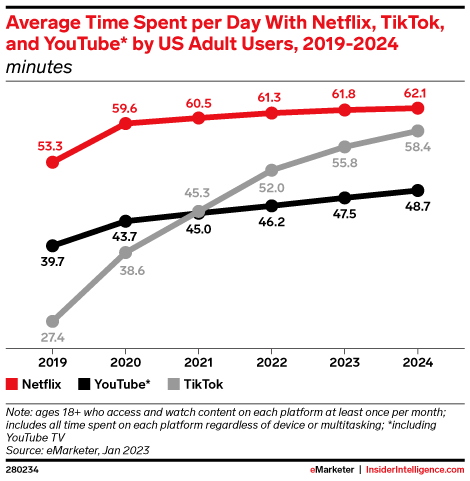
Source
18. Nearly 241.8 million people in the US watch YouTube, making it the second-most watched video platform after over-the-top (OTT) streaming services.
19. Globally, 92.3% of the users would watch any kind of video. Categorically speaking, music videos are the most popular, followed by comedy/meme or viral videos, video live streams, and tutorials.
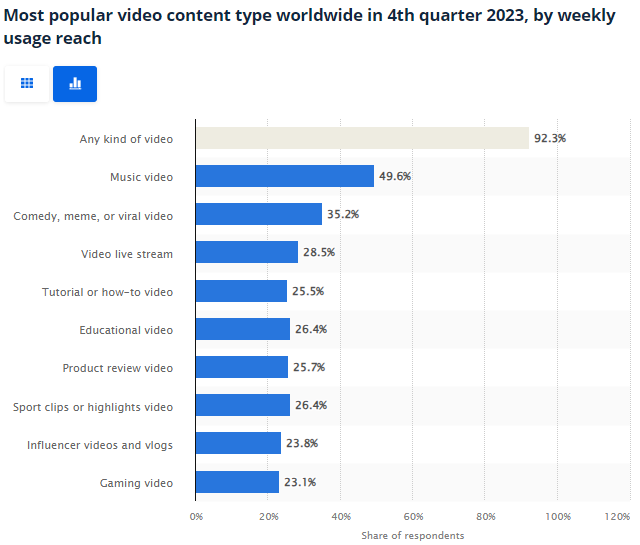
Source
20. In a 2024 survey, it was found that 58% of US adults aged between 18 and 34 use their devices to watch digital videos daily. On the other hand, 28% of those aged 35 to 54 use their devices to watch digital videos one or more times per week.
21. On average, people around the world watch 17 hours worth of video every week.

Source
Video SEO Stats
Since Google shows videos as top search results on its SERPs, it makes sense that video SEO gets so much attention. Even if your website doesn’t rank #1 for a certain keyword, you can still get traffic through your videos. The YouTube-Google partnership makes this possible.
Here are some video SEO statistics to consider.
22. According to SEO Minion, Google SERPs have 3 video listings on average. The result was based on multiple searches in different niches, including cleaning, SEO, marketing, real estate, finance, and food.

23. On average, the videos ranking on the first page of YouTube are 14 minutes and 50 seconds long. Also, the number of views, likes, shares, and comments correlates with high rankings on the platform.
24. According to an analysis of over a million videos, there’s no correlation between YouTube rankings and keyword-optimized descriptions.
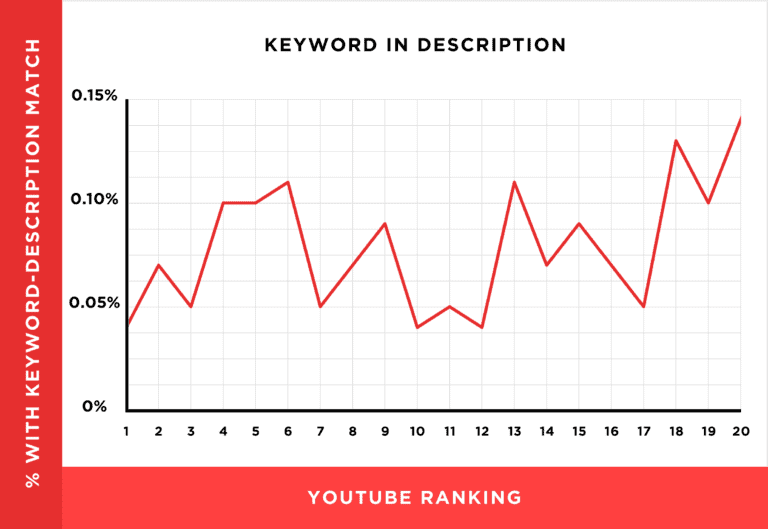
Source
Video Creation Stats
The crux of video marketing lies in getting the format and length right. Marketers should be aware of the current trends and use them to their advantage. These statistics will give you an idea of how brands plan on using video content in their marketing strategies and the kind of videos they focus on most.
25. 40% of marketers say that their companies have been making videos for 2 to 5 years, while 22% say they have been doing it for 6 to 10 years.
26. Product videos seem to be quite popular, as 45% of companies plan to make them in 2024, followed by 38% who want to make educational and instructional videos. Only 9% of companies plan to make company culture videos.
27. 27% of businesses spend between $1,000 and $4,999 on video content creation every month. Only 5% spend more than $20,000 a month on video content creation.
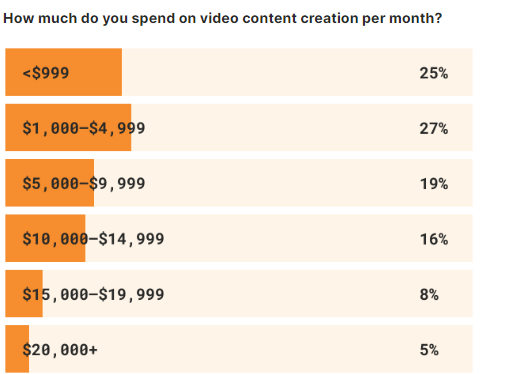
Source
28. 45% of companies create live-action videos, while 24% add animation to their videos.
29. 38% of companies use a mix of external and in-house resources for video production, while 24% prefer to outsource the entire process.
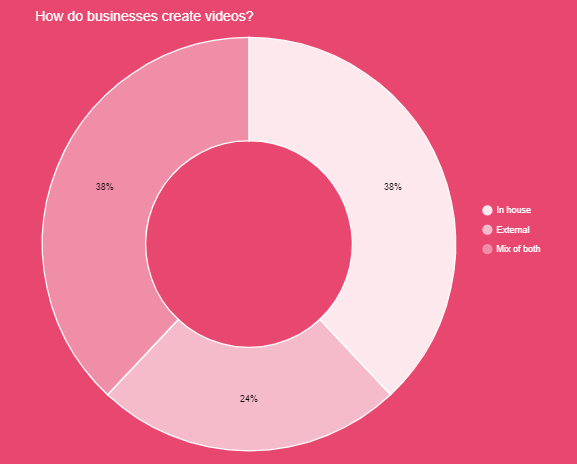
Source
30. In 62% of the companies, individuals at the workplace make videos. Meanwhile, 46% of marketers say that they have an in-house video production team. 21% of businesses opt for freelancers, while 16% work with video production agencies.
31. 57% of marketers use webcam or screen records to create videos, 52% have a full camera and light setup, 47% use live streaming platforms, and 46% report using online video editors.
32. Real estate companies have increased video creation by 132%. Financial services are creating up to 83% more videos, while professional services are creating 41% more videos.
33. On average, small businesses make 15 videos per year, medium businesses make 84 videos, and large businesses make 118 videos.

Source
34. In 2024, 35% of companies will make testimonial videos, while 48% will make explainer videos. These trends are popular in the B2B space, where businesses have to explain complex products or services to potential clients.
35. High-tech industry uses the highest number of user-generated videos at 684 videos per company. On the other hand, financial services use 681 user-generated videos on average per company.
Social Media Video Marketing Stats
Video-based social media platforms such as TikTok are popular not only among users but also marketers. The kind of social media videos marketers create range from short promotional Reels and TikTok videos to longer videos on platforms like YouTube.
Let’s take a look at some statistics related to social media video marketing.
36. 35% of marketers plan to create social media videos as a part of their video marketing strategy.
37. By 2027, TikTok is expected to account for 37% of the total social media share in digital video ad revenue.
38. On average, US users spend 61 minutes per day watching social videos. The duration is projected to increase to 68 minutes by the end of 2027.
39. On average, US adults spend 45 hours and 37 minutes on TikTok and 26 hours on YouTube per month.
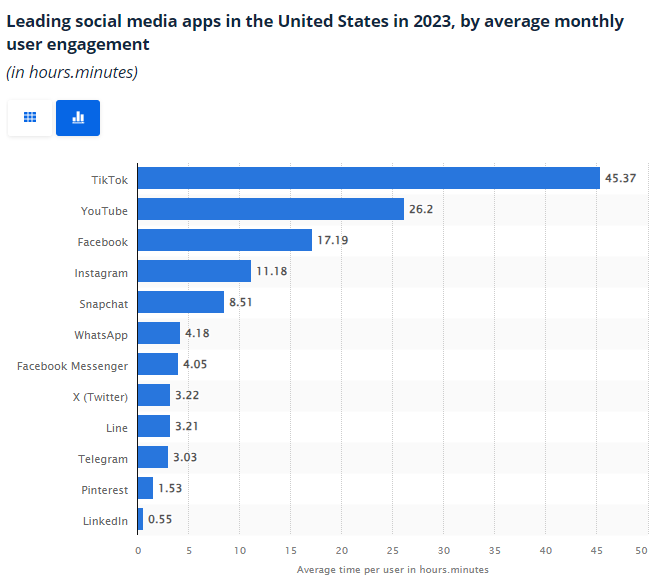
Source
40. 78% of people prefer to watch short-form videos on YouTube, while 54% of viewers cite TikTok as their preferred platform.
Video Marketing ROI Stats
As we’ve already discussed, video marketing can be expensive. That’s one of the reasons many marketers have not tried it yet. That’s why it’s important for marketers to see the possible return on investment (ROI) from their video marketing efforts.
These statistics shed some light on the effectiveness of video marketing in terms of conversion rates.
41. According to 90% of marketers, video marketing gives good ROI. The trend has remained consistent in the past few years, peaking in 2023, when 92% of marketers reported good ROI through video marketing.
42. 60% of marketers measure the success of their video marketing campaigns through video engagement. Similarly, 42% use audience engagement and 40% use video views as a benchmark for success.
43. 39% of marketers say that videos ranging in length from 30 to 60 seconds give the best ROI, compared to 28% of marketers that report videos 1 to 2 minutes in length as the most effective.
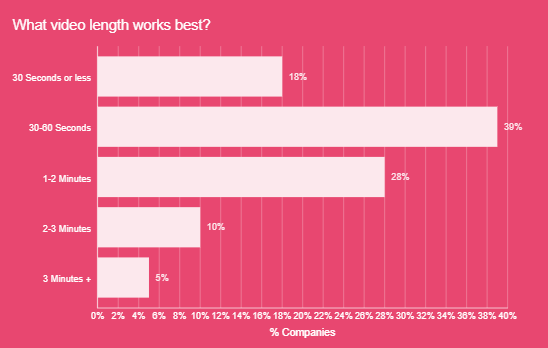
Source
44. Besides ROI, 88% of marketers say that video has helped them increase the user understanding of their product or service. That means videos, such as product demos, explainer videos, and testimonials, have been effective in educating potential customers about the product or service being marketed.
45. As for brand awareness, 90% of marketers report increased brand awareness through video marketing.
46. In 2024, video plays have gone up by 13% for small businesses, 13% for medium businesses, and 5% for large businesses.

Source
47. The education industry has the highest video play rate of 46%, followed by the media industry at 44%. The healthcare and services industries have a play rate of 11%.
48. Video marketing also helps increase traffic for a company’s social media pages and websites. According to 86% of marketers, video has been effective in driving traffic to their websites.
49. For A/B testing, 31% of marketers use different versions of the video, such as different lengths, intros, and music.
50. 87% of marketers report that video has helped them generate leads, indicating that videos are an effective way to capture the attention of potential customers and generate interest in a product or service.
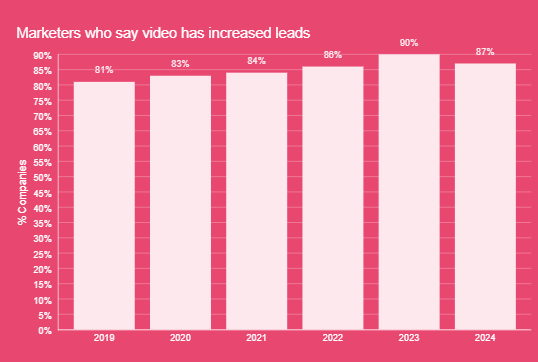
Source
51. 87% of marketers have seen a direct impact of videos on sales, reporting that video marketing has increased sales for their business.
52. Over the past years, video marketing has also improved customer service experiences, with 66% of marketers reporting that their video efforts have reduced the number of customer queries.
53. The engagement rate for a video under 1 minute is 50%. As the video length increases, the engagement decreases, declining to 17% for videos close to 60 minutes.
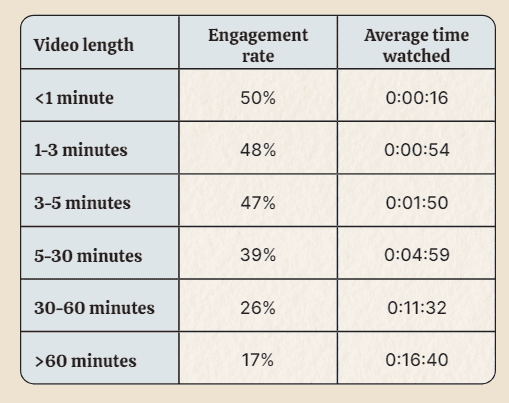
Source
54. 49% of marketers report that the CTA button is the most useful interactive feature for high video conversion, while 19% say an email collection form does the job.
55. The conversion rate is the highest (13%) for videos around 60 minutes in length. Short-form videos have a conversion rate of 1% to 4%.
Video Marketing Channel Stats
Choosing the right video marketing channel is important to the success of your campaign. Here are some helpful statistics to consider when deciding on which channel to use.
56. 90% of marketers have used YouTube for video marketing, followed by 86% who have used Facebook and 79% on Instagram. Other popular video marketing channels include LinkedIn, webinar, X, TikTok, and interactive video.
57. 78% of marketers say that YouTube is the most effective video marketing channel, while 71% hail Facebook as the most effective channel.
58. In a Vidico study, 37.9% of marketers said that their website or landing pages were very successful video marketing channels, whereas 23.8% regarded email marketing and newsletter campaigns as effective.

Source
59. A Wistia survey found that 67% of marketers publish videos on their websites, while 49% add them to email campaigns.
60. 4% of marketers use X as a channel for video marketing.
61. 41% of businesses add CTAs and annotations to improve the video playback experience, while 27% include closed captions or a transcript for the viewers. Only 11% of marketers add a brand logo watermark to their videos.
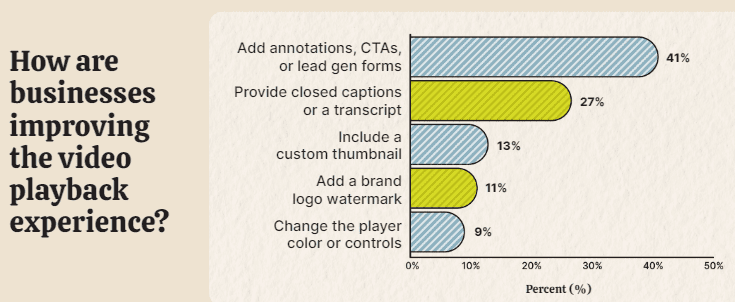
Source
Consumer Preferences Video Marketing Stats
When creating videos, marketers also have to account for what type of content consumers prefer. Here are some important preferences to keep in mind when planning your video marketing strategy.
62. Videos that range in length from 1 to 2 minutes have a retention rate of 56%, which means that most viewers will watch the video until the end.
63. 91% of customers have watched a video to learn more about a product or service.
64. 82% of people are convinced to buy a product or service after they watch a video about it.
65. 44% of customers would like to watch a video to learn about a product or service, compared to 16% who would read a manual and 15% who are willing to view an infographic.
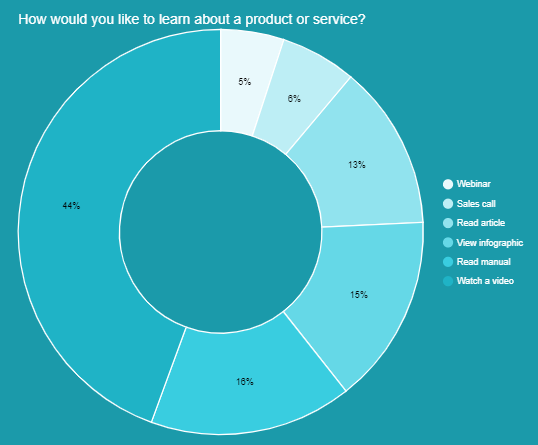
Source
66. Video marketing is also effective in the app and SaaS industry since 77% of people have bought or downloaded a software or app after watching a video about it.
67. 89% of people are willing to see more online videos from brands.
AI in Video Marketing Stats
Marketers are turning to AI video generators and editing tools to hone their marketing strategies. AI-generated videos can help optimize content for different platforms, such as social media and websites. Similarly, AI tools can help in video optimization and predictive analysis to help reach target audiences.
Here are some statistics to keep in mind.
68. 59% of businesses plan to use AI to auto-generate captions or transcripts, 50% will use it to generate scripts and outlines, and 35% plan to use it for generating visuals or fixing overdubs.
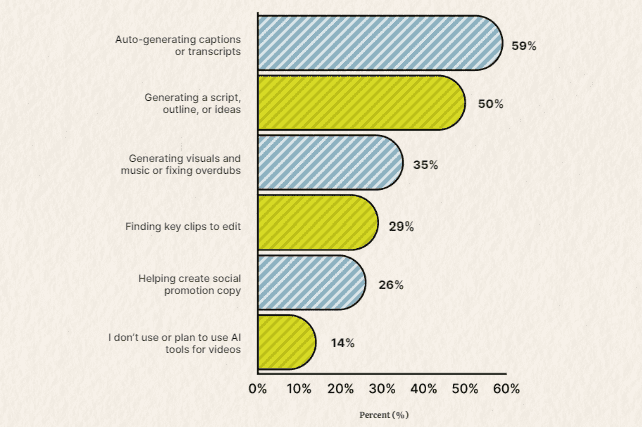
Source
69. 75% of businesses have already used AI to create videos.
70. 14% of marketers do not use AI for video marketing or don’t plan to use it in the future.
71. 46% of marketers believe that AI will complement the video creation expertise of professionals, while 12% say that it will not change much.
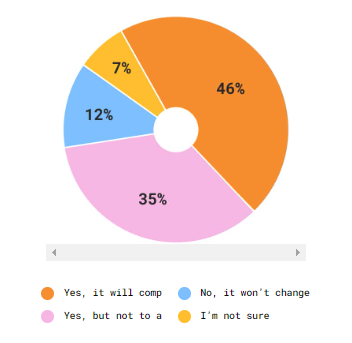
Source
72. 44% of marketers use visual generative AI tools, such as those to create videos and images.
73. 49% of marketers say that AI makes their content more personalized, while 50% say that it improves the quality of their content.
74. A big challenge in creating videos or any other kind of content using AI is content accuracy, as 47% of marketers report receiving incorrect information through AI.
Conclusion
To wrap up, these video marketing statistics indicate that businesses will have to focus heavily on creating videos in the future. In terms of video length, short-form videos will continue to dominate due to the increase in mobile usage and attention span.
As for platforms, YouTube and TikTok seem to be the most popular for businesses, with Instagram and Facebook not far behind. Businesses can measure the impact of their videos through metrics such as views, engagement, conversion rates, and shares. As the platforms and customer preferences evolve, marketers will have to adjust to new metrics based on their end goals.
As for the role of AI, it will surely assist marketers in making more and better video content. However, it should not be considered a replacement for human video marketers. Instead, it can provide the assistance and tools to enhance the quality and personalization of videos.


